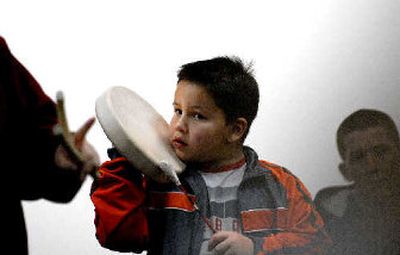Unique experience

The opponents sat facing each other in two rows several feet apart, some showing signs of confusion, others confident and most clacking sticks together to the beat of Norma Peone and her grandson Cody’s rhythmic chant.
“Hey-hey ho-o’oh…” Cody and Peone chanted in unison as they beat traditional handmade drums.
While North Idaho College students sipped on coffee, had noses buried in books or browsed the Internet in the lobby of the Edminster Student Union Building, muffled songs and soft drumming emanated from an adjacent room where about 50 people gathered to learn how to play the stick game as part of NIC’s American Indian History Month. This hands-on lesson at NIC was just one of many that Peone, secretary treasurer of the Coeur d’Alene Tribal Council and the tribe’s higher education coordinator, has helped with in North Idaho over the last four years.
“We used to do this just once a year,” said Sharla Chittick, an NIC history instructor and the Diversity Events Committee chairwoman. Now, she said, they try to hold the popular stick game and other American Indian activities demonstration every semester.
“It’s been exciting,” she said.
The stick game, at first somewhat confusing and purposefully distracting, is played by two teams that can have any number of participants, but is usually three to six people. Five wooden sticks are displayed in front of each team and one, the longer kick stick, is placed at center stage. Using two sets of smaller plastic pieces called bones, which were traditionally antlers or some other animal bone, each side tries to obtain all 11 wooden sticks as the team’s designated pointer guesses in which hand the opposing player has hidden the plain white bone, the other having a black stripe. Depending on whether the white bone is guessed correctly or not, the team will either lose a stick or gain the other team’s bones.
“If you have the bones, you play for sticks,” explained Mark Stanger, a Coeur d’Alene and Colville tribal member who helped at the NIC demonstration. “Lose one set, you still play for sticks. Lose both sets of bones, and it’s the other team’s turn.”
But, as usual, winning is much easier said than done.
“I’ve seen games last up to seven hours,” Peone told the NIC crowd. “It’s a betting game. Stick game is a fun game, but a harsh game. Sometimes people bet things they can’t lose.”
Through taunting trickery, traditional songs and wooden distractions, like the two strips of grooved wood placed in front of both NIC teams that operated like a communal drum, the team that is hiding the bones does its best to distract the other. But compounding the guessing game is the seemingly supernatural technique of some people to repeatedly and successfully hide the unadorned bone from their opponents, Stanger said.
“We call that a home run when they can do that,” he said.
The history of the stick game is steeped in American Indian lore, and the popularity of the game has fluctuated in recent years, Peone said. “Our people nearly lost it,” she said. “It used to be huge a few years ago, but then slowed down. Now it’s coming back.”
Tony Incashola, the director of the Salish-Ponderay Culture Committee in St. Ignatius, Mont., and announcer at the Arlee, Mont., Fourth of July powwow, one of the largest area powwows, has watched the ebb and flow of the stick game’s status over the years.
“I agree there was a short decline there for a while,” he said. However, as a sign that the game is coming back, each year the Arlee Powwow attracts more than 100 teams. “I think it’s doing fine,” he added.
And what about the game’s cloudy origins?
“There are a lot of stories. I’m sure every tribe has its own,” Incashola said.
The Coeur d’Alene Casino hosts three stick-game tournaments every year in April, July and over the Veterans Day weekend in November. Many tournaments have payouts of between $1,000 to as much as $20,000, and some stick-game players can even make a career out of traveling to different tournaments in a sort of circuit, Peone said.
“Some people can make a living out of it,” she said. But, she added, “Your luck will only last for so long any time you gamble.”
For sixth-grade student Dirk Seymour at the NIC stick games, the bluffing and diversions were the best part of the game.
“I liked the fact that you used distracting actions,” he said, adding that it was unlike any game he had played before.
It all adds up to a unique and time-honored American Indian experience, and one that Sanger is glad to see on the rise once again.
“The spirit and the singing, everyone singing the same songs, it’s like a big concert,” he said. “It’s just awesome.”